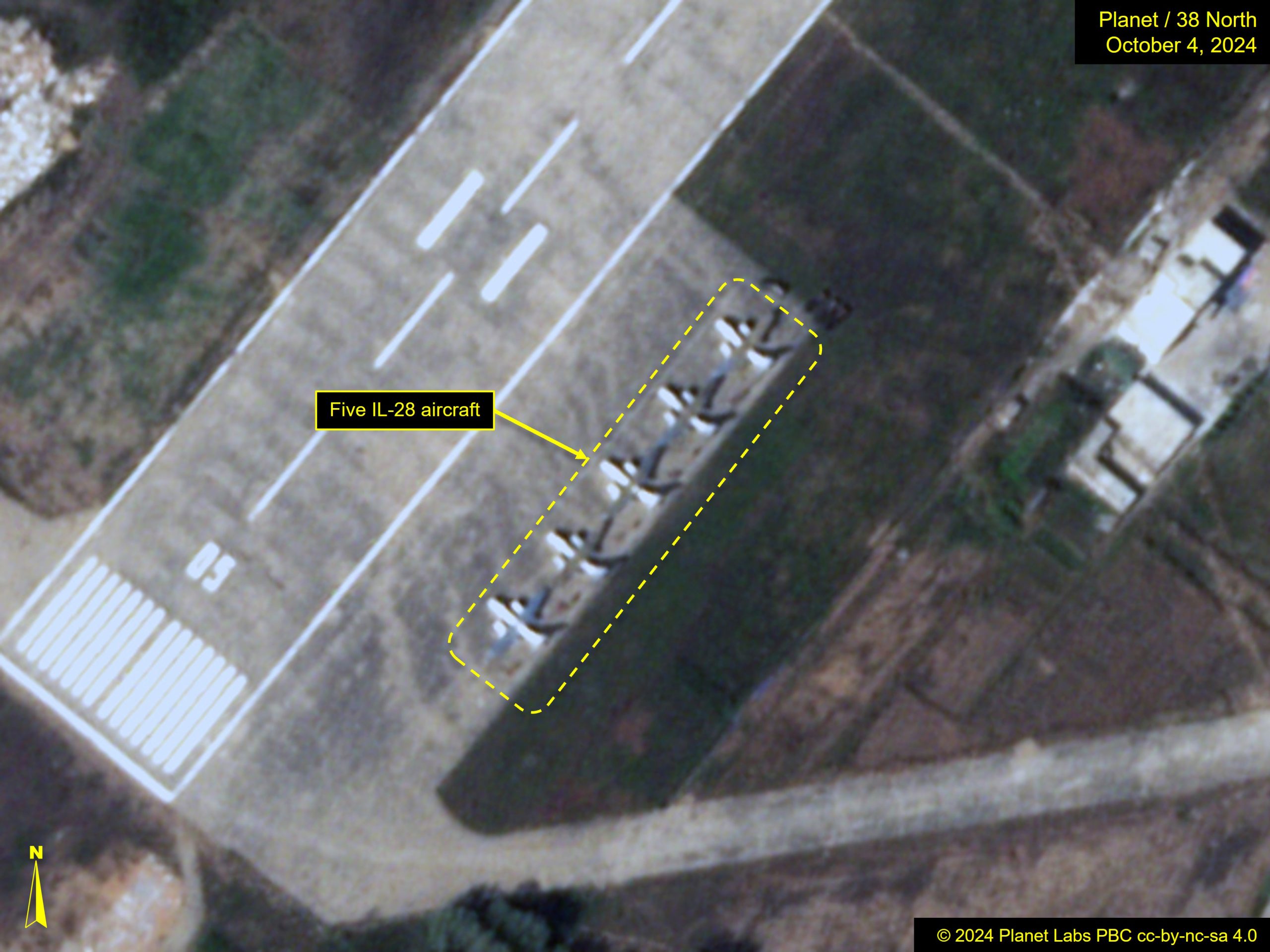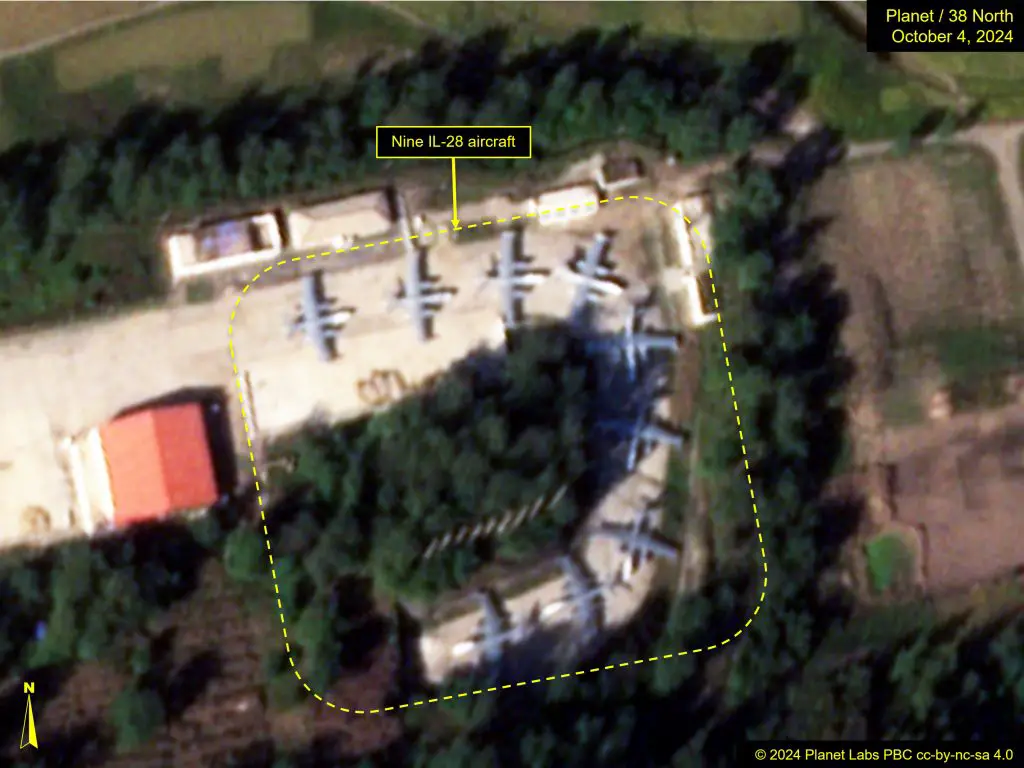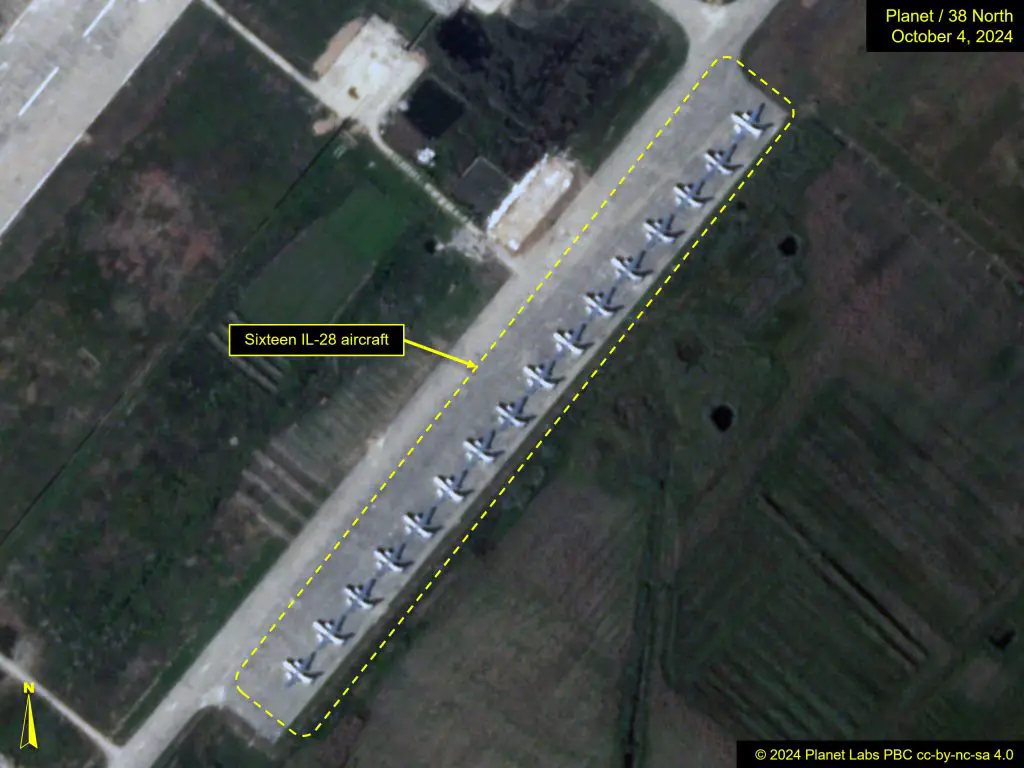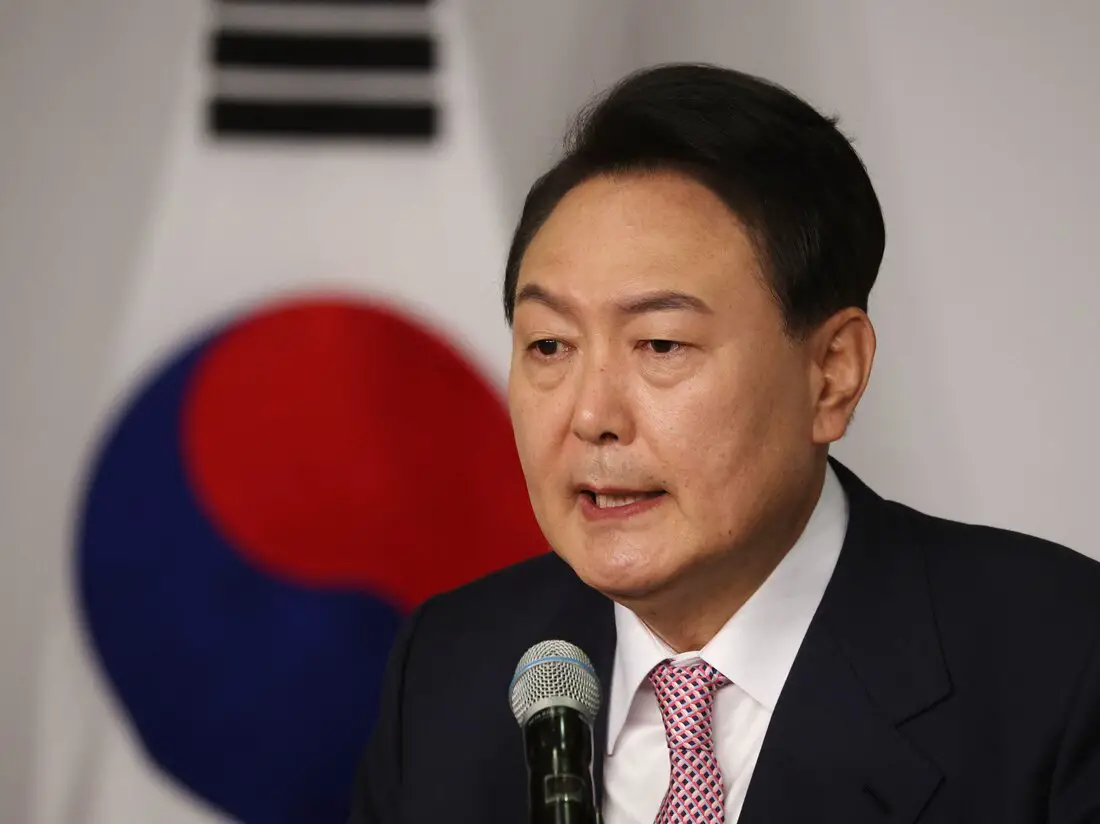In a striking move that signals North Korea’s increasing return to military normalcy post-pandemic, the recent redeployment of 31 Ilyushin IL-28 medium-range bombers to the Uiju Military Airfield has captured the attention of the global security community. This development follows a three-and-a-half-year period during which the airfield was repurposed as a quarantine center for incoming goods from China, a function it assumed during the height of North Korea’s COVID-19 lockdown measures.
The images captured on October 4, 2024, reveal the meticulous organization and restoration efforts at the airbase. After a prolonged hiatus, the IL-28 bomber regiment, previously stationed on the country’s east coast during Uiju’s quarantine phase, has returned to Uiju Airfield, balancing the nation’s bomber fleet between the east and west coasts. This strategic rebalancing could signal North Korea’s readiness to resume a more aggressive military posture and enhance its aerial capabilities amid a rapidly evolving geopolitical landscape.

Pandemic’s Pause on Military Aviation
The pandemic brought North Korea’s typically high-alert military operations to an unusual standstill. Uiju Airfield, located near the border with China, underwent a dramatic transformation from a base for bomber aircraft to a logistical hub supporting the country’s stringent quarantine protocols. The transformation began in March 2021, a year after North Korea’s government closed its borders to curb the spread of COVID-19. With the entry of goods largely restricted, the airfield was tasked with handling incoming cargo through controlled quarantine procedures.
The quarantine center became fully operational in December 2021, as trains from China delivered goods, and containers steadily populated the airfield’s main runway. Satellite imagery from this period shows a significant disruption of normal airbase activities, with rows of quarantine warehouses and restricted movement of aircraft. It was only in early 2024 that these containers began to disappear, signaling the first steps toward restoration. The gradual reduction in container numbers continued through the summer, and by August, the airfield had been cleared, laying the groundwork for the bombers’ return.
While Uiju remained offline, North Korea’s 24th Bomber Regiment, responsible for operating the IL-28 bombers, was temporarily stationed at Changjin Airbase and Sondok Airbase, both located on the east coast. These relocations reflected North Korea’s ongoing commitment to military preparedness, even as its domestic logistics infrastructure was repurposed to support pandemic-related efforts.

Implications of the IL-28 Return
The reappearance of IL-28 bombers at Uiju Airfield as seen in the October 2024 satellite imagery is far more than a symbolic gesture; it represents a substantial shift in North Korea’s strategic capabilities. The imagery, captured on October 4th, shows five aircraft on the southeast alert apron, sixteen aircraft lined up on the northeast apron, and nine more positioned at the far eastern apron, queueing in front of one of two storage tunnels. This restoration of airpower at Uiju is particularly noteworthy for its scale, with 31 bombers now active at the site after a prolonged absence.
The IL-28, also known as the Harbin B-5, is a Cold War-era bomber that remains a crucial element in North Korea’s conventional aerial forces. The aircraft, though technologically dated, can still carry a range of payloads, including conventional bombs and potentially even nuclear weapons. Their return to Uiju, following the restoration of the airfield, suggests a re-establishment of North Korea’s ability to project airpower along its western front. This is especially concerning given the airfield’s proximity to China and the increased military posturing observed throughout the Korean Peninsula.
The redeployment of these bombers likely serves multiple purposes. First, it restores North Korea’s military equilibrium, with strategic assets now stationed on both its east and west coasts, enhancing its ability to respond to threats from different directions. Second, the return of the bombers to Uiju may be intended to send a message to the international community, particularly in the context of increasing tensions in the region, such as the ongoing military drills by South Korea, Japan, and the United States, as well as North Korea’s advancing missile and nuclear programs.
From Quarantine Center to Restored Airbase
The repurposing and subsequent restoration of Uiju Airfield over the past three and a half years serves as a vivid example of North Korea’s adaptive military strategy. When the pandemic first hit, North Korea swiftly reconfigured Uiju to function as a quarantine facility. Satellite imagery from mid-2021 shows the airfield cluttered with quarantine structures and cargo containers as the regime sought to secure incoming goods while minimizing the risk of COVID-19 transmission. This transformation represented a unique use of military infrastructure for civilian and logistical purposes.
By April 2024, the restoration of the airbase was visibly underway. The containers that once lined the runways were being systematically removed, and the quarantine warehouses were dismantled. The resumption of aircraft operations was signaled by paint-marking work on the runway in September, followed by the re-establishment of bomber operations in early October.
One notable aspect of this process is the partial preservation of fighter aircraft at Uiju throughout its quarantine phase. The imagery suggests that at least one IL-28 bomber, likely unfit for flight, remained parked in a revetment near the airfield’s aircraft tunnels. Additionally, two other revetments housed MIG-21 fighter jets, which were not relocated during the quarantine period. This raises questions about the logistical challenges North Korea faced in balancing military readiness with public health efforts, as well as the operational status of its air assets during this time.

Preparing for Future Conflict?
The return of bombers to Uiju Airfield comes at a time when North Korea is ramping up its rhetoric and military activities, raising concerns about future provocations. In recent months, Pyongyang has conducted multiple missile tests, including tests of intercontinental ballistic missiles (ICBMs), and has openly vowed to expand its nuclear arsenal. The bomber regiment’s return could be seen as part of this broader escalation, signaling North Korea’s readiness to assert itself militarily, both regionally and globally.
The IL-28 bombers, while outdated compared to modern fighter jets, still pose a significant threat in the region due to their ability to deliver substantial payloads over medium-range distances. Their presence at Uiju may also be aimed at reassuring North Korea’s military leadership that the country’s air force remains capable of deterring external threats.
More broadly, the restoration of Uiju Airfield suggests that North Korea is moving back toward pre-pandemic military operations, refocusing on its defense and deterrence strategies as it emerges from the COVID-19 crisis. While the country remains isolated economically and diplomatically, its leadership continues to prioritize military strength, a key component of its internal stability and international posture.

Uiju Airfield’s Dual Role Reflects North Korea’s Strategic Ambiguity
The transformation of Uiju Airfield from a quarantine center back into a fully operational military base underscores the flexibility and adaptability of North Korea’s military strategy. While the pandemic temporarily shifted the country’s priorities toward logistics and public health, the restoration of the airfield and the return of bomber aircraft signal a return to the regime’s long-standing focus on military readiness and deterrence.
The global security community will be closely monitoring the developments at Uiju and the movements of North Korea’s bomber fleet. As tensions on the Korean Peninsula continue to simmer, the reactivation of this critical airbase serves as a stark reminder of North Korea’s enduring focus on its military capabilities, even in the face of domestic and global challenges. The redeployment of IL-28 bombers at Uiju Airfield will likely fuel further speculation about Pyongyang’s intentions and the potential for future conflict in the region.
Security Dilemmas and Public Sentiment
For South Korea, the return of these bombers heightens the already precarious security environment. North Korea’s ability to project airpower across both coasts, with Uiju on the west and its previous bomber deployments on the east, places South Korea in a difficult position:
North Korea’s actions could spur South Korean political leaders to further escalate defense spending. The government in Seoul has already been boosting its military budget in response to North Korea’s continued missile tests and nuclear advancements. However, the redeployment of bombers will likely necessitate more investment in air defense systems, particularly those capable of neutralizing medium-range bomber threats. This could trigger political debates within South Korea about resource allocation, economic priorities, and national security.
The North’s military posturing traditionally fuels public anxiety in South Korea, leading to increased demand for government transparency and action. The fear of potential aerial threats from North Korea, especially from bombers capable of delivering significant payloads, may galvanize more conservative factions in South Korean politics to advocate for a stronger military stance. On the other hand, more progressive political elements might argue for renewed diplomatic engagement with North Korea, pushing back against further militarization.
South Korean President Yoon Suk-yeol’s administration, which has adopted a more hawkish stance toward North Korea, will likely face heightened pressure to respond firmly to this military development. Yoon’s government has taken a hardline approach, focusing on strengthening the U.S.-ROK alliance (Republic of Korea) and deepening military cooperation with Japan. The North’s bomber redeployment will likely force the South Korean government to reevaluate its defensive posture, particularly in the context of aerial threats, and may lead to further joint military exercises with the United States.
South Korea’s Regional and International Position
The redeployment of bombers at Uiju also has a profound diplomatic impact, not only within inter-Korean relations but across the wider regional and global landscape.
The bomber redeployment at Uiju is a clear signal from Pyongyang that it is prioritizing its military strength over diplomatic engagement. Despite intermittent calls for dialogue from Seoul, this move will likely be perceived as an act of escalation, making any meaningful negotiations less likely in the near term. The South Korean government, while open to diplomacy, will find it increasingly difficult to justify engaging North Korea while Pyongyang continues to project such military force. This dynamic risks further eroding the confidence-building measures that have been attempted in the past.
The U.S.-South Korea alliance is built around collective defense and deterrence strategies, with North Korea’s military capabilities being a central concern. The return of North Korean bombers, capable of carrying both conventional and potentially nuclear payloads, adds urgency to U.S.-ROK military cooperation. South Korea is likely to deepen its reliance on the U.S. military umbrella, especially air defense and surveillance capabilities. This, in turn, could provoke Pyongyang to further harden its diplomatic stance against both South Korea and the United States, framing joint military actions as provocations.
Diplomatic relations between South Korea and Japan, while historically fraught, have seen significant improvement, particularly on the military front. Both countries view North Korea’s missile and bomber capabilities as an existential threat. The redeployment of North Korean bombers will likely prompt both Seoul and Tokyo to intensify their joint military exercises, further aligning their defense strategies under the auspices of the U.S.-Japan-South Korea trilateral framework. This dynamic will deepen the regional divide, potentially pushing Pyongyang toward more isolationist policies, as it perceives growing regional hostility.
South Korea will have to carefully navigate its diplomatic relations with China, which remains North Korea’s primary ally. The Uiju Airfield’s proximity to the Chinese border could be seen as an attempt by North Korea to signal strength not only to its enemies but also to its ally, China. For South Korea, balancing its increasingly close military ties with Washington while avoiding antagonizing Beijing remains a delicate task. Any overtly aggressive response from Seoul could be met with disapproval from China, further complicating South Korea’s geopolitical position.
As North Korea continues to focus on military escalation rather than diplomacy, South Korea might seek greater international support for reinforcing economic sanctions. This, however, will face challenges, especially considering North Korea’s already deeply sanctioned economy. Furthermore, South Korea might also explore diplomatic sanctions, pushing for North Korea’s further isolation on international platforms such as the United Nations.
A Fragile Diplomatic Landscape
The redeployment of bombers to Uiju Airfield represents a direct challenge to South Korea’s political stability and regional security posture. While the immediate consequences will likely be felt through increased military preparedness, the long-term impact may be seen in the deterioration of inter-Korean diplomacy and heightened tensions between the two Koreas. With North Korea sending a clear signal that it is prepared to assert its military dominance, Seoul will face difficult decisions in both its domestic policy and foreign relations.
South Korea’s government must now balance the need for increased defense measures, diplomatic efforts to prevent further isolation of North Korea, and maintaining the U.S.-ROK alliance, all while managing its internal political divisions on how to best address the growing threat from the North.




